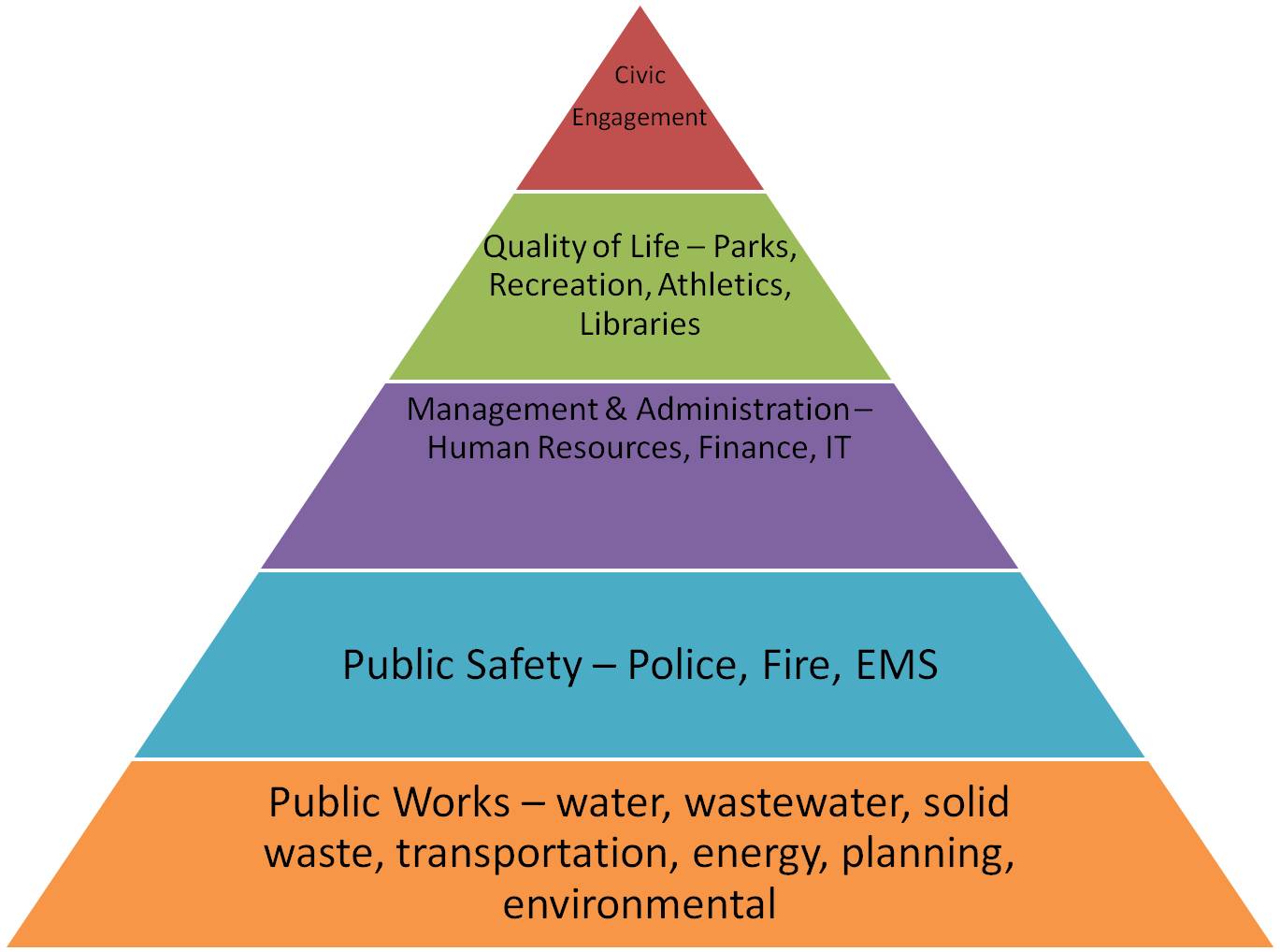
As part of his Wojo’s Wandering Wisdom series, Matt Wojnowski, City of Killeen, TX Assistant Director of Parks and Recreation muses on how Maslow’s Hierarchy of Needs looks when applied to local governments.
Learn a little more about Matt (Twitter) HERE.
In my high school psychology class, I was introduced to Maslow’s “Hierarchy of Needs.” Abraham Maslow had presented the hierarchy to the world in the psychology theory, “A Theory of Human Motivation” in 1943. Maslow wrote that humans were motivated to achieve certain needs, and then once those needs were fulfilled, we would seek out the next needs to be fulfilled, thus a hierarchy of needs.

Working in local government, I have been thinking recently about municipalities priorities in comparison to Maslow’s “Hierarchy of Needs.” This thinking lead to the creation of Wojo’s “Hierarchy of Municipal Functions.” In my hierarchy I propose there are various levels or steps to achieve municipal realization. They are Public Works, Public Safety, Management & Administration, Quality of Life, and Civic Engagement. Let me expound on my reasoning for the level of functions.
Public Works
Public Works is at the base of Wojo’s “Hierarchy of Municipal Functions.” (Yes, #webuiltthiscity!) Public Works is the most basic and essential function for two main reasons. First, to sustain life in a municipality there must be water, a good clean source of water. Without it a community of individuals is not possible. Humankind originated near water sources and continues to populate areas with water nearby. Public works directly supports the primary revenue sources of municipalities – property tax and sales tax. Without utilities for residential homes and businesses, local government would not have revenue to support city functions.
 To go meta on you – Within the pyramid of needs, there is a secondary hierarchy dependent upon the services needed to sustain life and support the tax base. From bottom to top, I would list those as water, wastewater, solid waste, transportation, energy, planning, and environmental (including drainage/stormwater). Infrastructure is necessary to support these public work functions. If you’ve played Sim City, you will remember that public work services were necessary to support residential, commercial, and industrial zones – water/sewer, energy, and transportation.
To go meta on you – Within the pyramid of needs, there is a secondary hierarchy dependent upon the services needed to sustain life and support the tax base. From bottom to top, I would list those as water, wastewater, solid waste, transportation, energy, planning, and environmental (including drainage/stormwater). Infrastructure is necessary to support these public work functions. If you’ve played Sim City, you will remember that public work services were necessary to support residential, commercial, and industrial zones – water/sewer, energy, and transportation.
Public Safety
In line with Maslow’s Hierarchy, I place Public Safety at the higher base level. Residents and business within your community must feel safe and protected. If they don’t they will often move to a community that does feel safe. Residents want to feel safe everyday, and especially, when a disaster strikes. Police, Fire, EMS, and Emergency Services bring comfort and peace to the community.
Management and Administration
Management and administration rests in the middle in Wojo’s “Hierarchy of Municipal Functions.” This includes supporting departments to the functions below (and above) in the hierarchy including: human resources, finance, information technology, etc. The management and administration functions assist in carrying out all administrative functions of the municipality.
Quality of Life
 “Quality of Life” functions are at the bottom of the higher level in my “Hierarchy of Municipal Functions.” Quality of Life includes parks, recreation, athletics, senior center, and libraries. Parades and festivals may be help to instill the community’s culture and history to residents. These are the local government functions that often are most visible and bring the most enjoyment to citizens. Municipalities without quality of life functions will find their residents traveling outside the area to find these activities. The Quality of Life functions are provided through partnerships with counties, states, special districts, or other agencies.
“Quality of Life” functions are at the bottom of the higher level in my “Hierarchy of Municipal Functions.” Quality of Life includes parks, recreation, athletics, senior center, and libraries. Parades and festivals may be help to instill the community’s culture and history to residents. These are the local government functions that often are most visible and bring the most enjoyment to citizens. Municipalities without quality of life functions will find their residents traveling outside the area to find these activities. The Quality of Life functions are provided through partnerships with counties, states, special districts, or other agencies.
Civic Engagement
 Civic engagement tops Wojo’s “Hierarchy of Municipal Functions!’ This includes those functions which drive community involvement and participation – boards and commissions, citizen academies, partnerships with outside organizations, and community surveys. Social media is a useful tool within civic engagement. If done right, a local government’s social media informs, educates, and promotes important community issues. Civic engagement is vital in a local government achieving something that is greater than the sum of its parts.
Civic engagement tops Wojo’s “Hierarchy of Municipal Functions!’ This includes those functions which drive community involvement and participation – boards and commissions, citizen academies, partnerships with outside organizations, and community surveys. Social media is a useful tool within civic engagement. If done right, a local government’s social media informs, educates, and promotes important community issues. Civic engagement is vital in a local government achieving something that is greater than the sum of its parts.
 I hope Wojo’s “Hierarchy of Municipal Functions” have caused you to “stop, collaborate, and listen” to the needs and order of local government functions. With our increasing demands from taxpayers and mandates from higher level governments, municipalities are constantly analyzing, balancing, and prioritizing to achieve greatness within their community.
I hope Wojo’s “Hierarchy of Municipal Functions” have caused you to “stop, collaborate, and listen” to the needs and order of local government functions. With our increasing demands from taxpayers and mandates from higher level governments, municipalities are constantly analyzing, balancing, and prioritizing to achieve greatness within their community.

